A Knitted Lace Shawl pattern Written instructions: 5-6 Charts: pages 7-10 Aino Haikala Designs
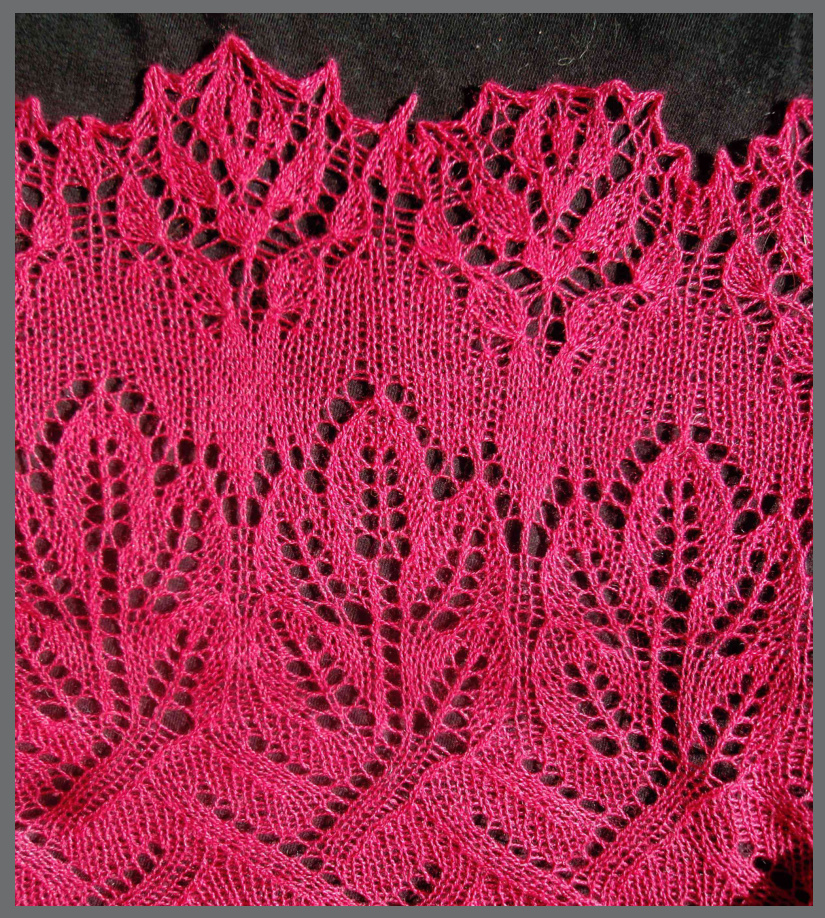
"Each color of roses has a meaning of their own. Red is for true love. White signals innocence. Yellow means friendship. And blue is for mystery.
Materials
Teetee Elegant 50 g / 500 m (546 yards) (70 % wool, 30 % silk) or any other similar yarn. The total amount of yarn needed: 900 yards.
Needle size
3,5 mm (US 4) needles.
Gauge
18 stitches and 35 rows = 4" or 10 cm in Branch pattern on size 3,5 mm needles using lace weight yarn. The diameter of the roses is 8 cm. Exact gauge is not important. It's more important to have a needle size which gives you roses you like. Do note that a looser gauge will result in the use of more yardage.
Finished Size
200 cm (80 inches) across by 75 cm (30 inches) down.
Structure
I have been trying to figure out how to knit roses for a long time. I couldn't find a way until I was swatching for another project and realized that Estonian stitches could be used creatively for that purpose. After long hours of swatching, the rose design was finally created. This time I also played a bit with the triangular form. I tried to achieve something more effortless and natural than pure geometric shapes are. The shawl is knitted from the center of the neck outwards. There is a three stitch garter stitch border which is formed by always knitting the first three and the last three stitches. All the wrong side rows are worked k3, p to 3 sts from end, k3. The shape is nearly triangular. In the beginning it is formed by one increase on each edge and two increases on the center. In the leaf section and in the rose section the increases are made in three different points in the shawl, once in the center and once in both the sides. This pattern consists of four different charts. The set-up chart is always knitted once. It has a branch pattern which continues in the body of the shawl. The branches end into rose leaves in leaf charts. Finally there are the rose charts, which have the instructions for the roses in the edge. Only the set-up chart has a center stitch. The branch chart has center panel and in the leaf and rose charts the increases are hidden in increasing motifs.
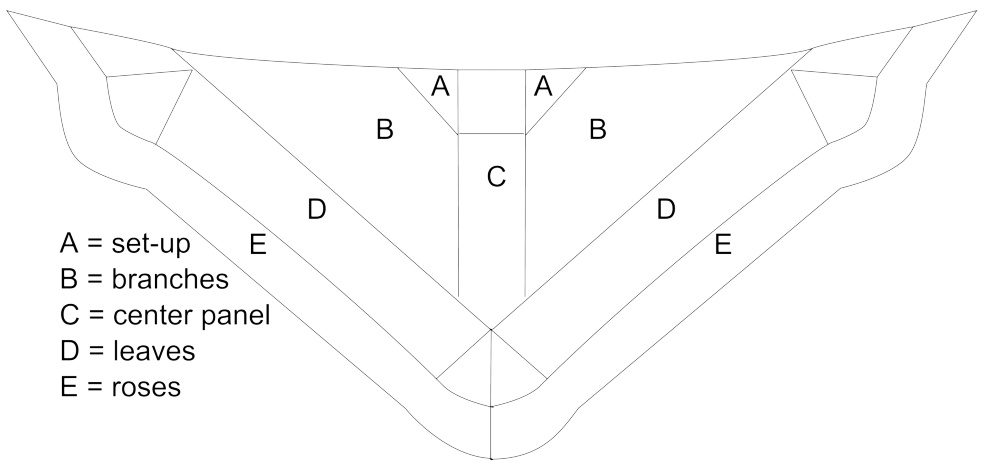
Modularity
You can change the size of this shawl by knitting different amounts of the branch pattern. The set-up chart and the leaf and the rose charts are always knitted once. You can repeat the branch chart as many times as you wish. When you are knitting the leaves one increasing panel should be always in the center. The increasing panels in the sides should be placed about 1/3 of the side. Use increasing panels when knitting rose charts as in the figure, below the increasing leaves panel.
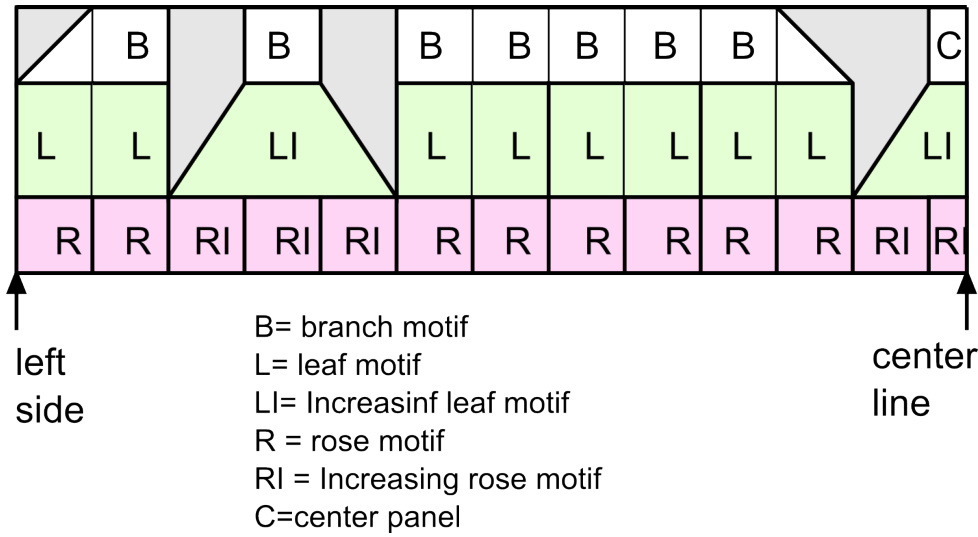
For left-handed knitters
If you are a mirror-knitter (you knit from the right needle to the left needle) you can knit the right-side rows of the charts from right to left using the normal chart key or from left to right using the chart key below. The shawl is slightly asymmetric. If you follow the charts from right to left your finished object will be a mirror image of the shawl in the pictures.
Notes
· The charts do not include three stitch garter stitch border. · The charts include center stitch in set-up chart and center panel in branch chart. There's no center stitch nor center panel in leaves or roses charts. · On wrong side rows knit the first three and the last three stitches and purl all Other stitches. · The colored squares in the roses chart will help you to see the outlines of the petals, but it's not necessary to see the colors in order to knit the shawl. · If you want to have less space between the roses and the leaves, you can omit rows 35 and 36 of the leaves charts.
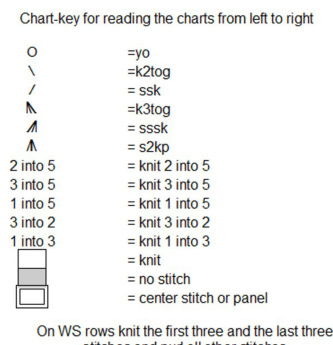
stitches and pur allother stitches
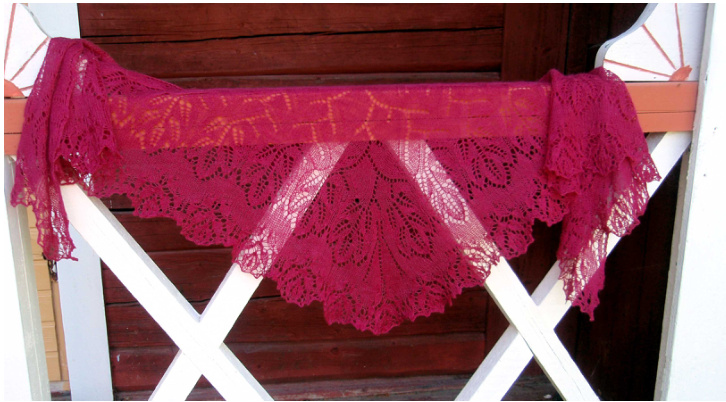
Abbreviations
k = knit k2tog = knit 2 together ssk = slip1, slip1, knit the slipped stitches together through the back loop k3tog = knit 3 together sk = slip1, slip 1, slip 1, knit the slipped stitches together through the back loop s2kp = slip 2 stitches together knit-wise. Knit 1 and pass the 2 slipped stitches over theknittedstitch knit 2 into 5 = \*k2tog through back loop without dropping the stitches from the holding needle, yo\*, twice for the same stitches, knit the same stitches again and now drop the stitch from the holding needle. As a result there are five stitches on the needle. knit 3 into 5 = \*k3tog through back loop without dropping the stitches from the holding needle, yo\*, twice for the same stitches, knit the same stitches again and now drop the stitches from the holding needle. As a result there are five stitches on the needle. knit 3 into 7 = \*k3tog through back loop without dropping the stitches from the holding needle, yo\*, three times for the same stitches, knit the same stitches again and now drop the stitches from the holding needle. As a result there are seven stitches on the needle. knit 1 into 5 = \*k through back loop without dropping the stitch from the holding needle, yo\*, twice for the same stitch, knit the same stitch again and now drop the stitch from the holding needle. As a result there are five stitches on the needle. knit 2 into 3 = \*k2tog through back loop without dropping the stitches from the holding needle, yo\*, once for the same stitches, knit the same stitches again and now drop the stitches from the holding needle. As a result there are three stitches on the needle. knit 1 into 3 = \*k through back loop without dropping the stitch from the holding needle, yo\*, once for the same stitch, knit the same stitch again and now drop the stitch from the holding needle. As a result there are three stitches on the needle.
Instructions
CO 3 sts provisionally using scrap yarn. Knit 11 rows with main yarn. Do not turn the work around but rotate 90 degrees clock-wise, yo, pick up and knit 2 sts from the garter stitch edge of the piece, yo, place a marker (this is the center spine), pick up and knit 1 st, yo, pick up and knit 2 sts, yo, undo provisional cast-on and knit the 3 live sts. (15sts) K3, purl to last 3 sts, k3. Work rows 1-18 of the set-up chart once. (51 sts) Work rows 1-32 of the branch chart 4 times.(307 sts) Each repeat of the branch chart adds two motif repeats on both sides of the shawl. Work across each row (1-36) of the leaf motif and increasing motif in the following order: normal motif twice, increasing motif once, normal motif six times, increasing motif once (this corresponds to the center panel), normal motif six times, increasing motif once and normal motif twice. Please note that the first and the last normal motif are knitted differently from other repeats as well as the second increasing motif. The changes to be made are described below the charts. (526 sts) Work accross each row (1-20) of the rose charts in the following order: normal motif twice, increasing motif three times, normal motif six times, increasing motif three times, normal motif six times, increasing motif three times, normal motif twice. Bind off loosely, wash and block.
Charts
Aino Haikala =yo /=k2tog = ssk M=k3tog M= sssk M= s2kp 2 into 5 = knit 2 into 5 3 into 5 = knit 3 into 5 1 into 5 = knit 1 into 5 2 into 3 = knit 2 into 3 3 into 7 = knit 3 into 7 1 into 3 = knit 1 into 3 = knit = no stitch = center stitch or panel On WS rows knit the first three and the last three stitches and purl all other stitches Set-up

Branches
Right side

Left-side and the center panel

Leaves
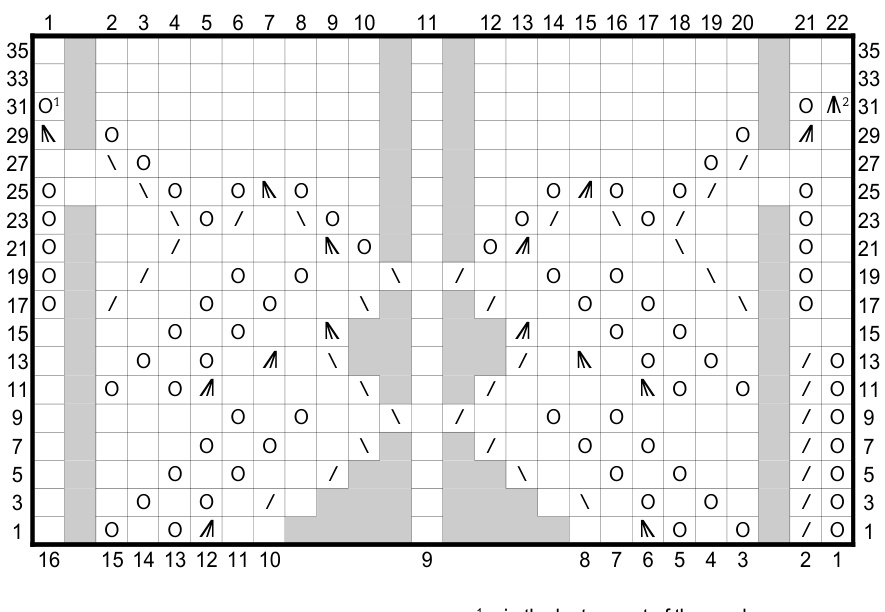
1 = in the last repeat of the row k 2 = in the first repeat of the row k2tog Increasing motif

\* in the center line (second repeat) k
Roses
Normal motif

Increasing motif










